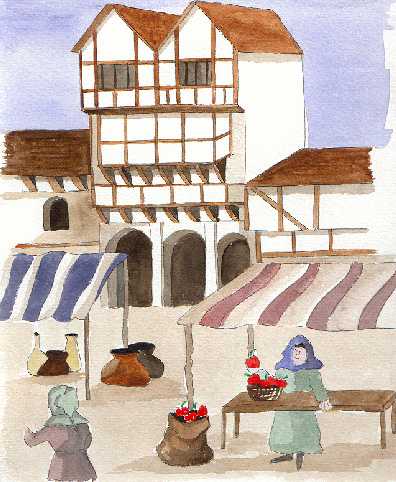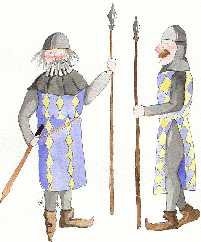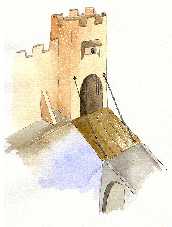 |
 |
 |
| |
Supported by the Feudal system, life in Europe became more stable after the year 1000 as strong rulers brought order and peace to the new nations. This was the reason for the growth of cities and towns, the development of trade and the increase of population. As the Middle Ages progressed, merchants and craftsmen were required. These people didn't use to work the land but sell their services. Therefore, they tended to gather where markets were held and they started building their houses on the roads which led to these markets, forming the nucleus of a town. |
|
| |
 |
|
Living conditions in the town were hard, though. Streets were muddy, smelly and unhygienic, as people used to throw their rubbish into the open drains. That's why wealthy people used to carry oranges inside their handkerchiefs in their hands, so that the bad smell could be camouflaged. There was also a constant threat of fire, as houses were built with timber and thatch. The centre of these towns was the market place, usually centred at a crossroads, where merchants used to gather to sell and exchange goods which had been transported by pack-horse or cart. |
|
| |
Traditionally, the boundaries of these towns were surrounded by impressive stone walls, which not only protected the inhabitants from any exteior threat but also made sure that merchants and other visitors entered through the gate, where they had to pay a toll to come in. |
|
| |
People got up at daybreak, then a bell would be rung meaning that the town gates were opened and the business had begun. At night, the curfew bell rang, meaning that people had to finish work and go back home. There didn't use to be lights in the streets so they could be very dangerous after dark. Nightwtatchmen patrolled the streets with lanterns. Once at home, people used to put out their fires, close the window shutters, bar their doors and go to bed. It was then, at dusk, that the town gates were closed again. |
|
 |
|
| |
 |
|
As trade grew, so did the town. But we must take into account that medieval towns were small. In England, the largest one was London. In the year 1300, it had a population of 60,000 people, very few if compared with the number of inhabitants it has nowadays. Towns used to be part of the lord's domain at first, but as merchants grew wealthier, they became independent business centres. Town-dwellers agreed to pay a fixed sum each year in exchange for a royal charter which granted them the right to govern themselves. Then the town became a free borough with the power to make their own laws, form trade guilds and raise taxes. People became then free citizens or burgesses. |
|
| |
As you may remember, at that time there was the belief that hierarchy of men was ordered by god. However, some men didn't fit in this scheme. So, merchants who became wealthy could aspire to social equality with a knight, and later on, some merchants were noblemen from birth. |
|
 |
Information search activity Find out as much as you can about the guilds. |
|
 |
 |